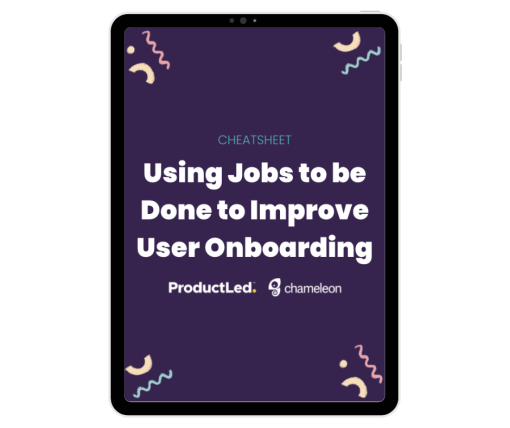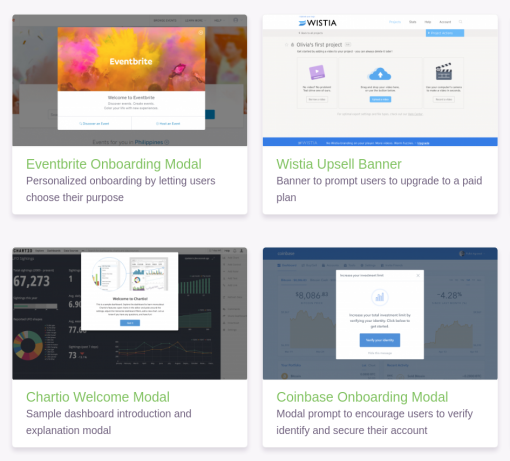Feeling lost, abandoned, and unappreciated is the number 1 reason customers move away from your product or service. It is also the reason why 52% of customers will never touch your brand again. How can you ensure that both your current customer base and future prospects feel valued? Through qualitative research.
By regularly collecting qualitative data, you are constantly engaging with your customer. And, by engaging with your customers you are ensuring product-market fit at all levels.
Whether you’re keen to learn about qualitative research in general or want to understand how you can put the methods themselves into practice – you’re in the right place.

🎬 Webinar: Using Jobs to be Done to Improve User Onboarding
Learn how to customize onboarding experiences at scale, and help steer users to key "aha!" moments.
What is qualitative research?
Qualitative research involves finding a solution to a particular problem. There are two main types of data collection: qualitative and quantitative research.
Quantitative data is numerical and therefore easily quantifiable. Because of the ease at which quantitative data can be measured it has been relied upon more so than qualitative in the past, particularly within business.
However, recently there has been a shift towards qualitative research and the value that it can bring to succeeding in finding a product-market fit. Qualitative research provides deep and broad insight into how your customers interact with your product, what they feel works (and what doesn’t).
Let’s take a closer look at some of the advantages of qualitative research:
Allows for individual insight into each of your users 👫
The qualitative data collected is based upon the participant’s world view, rather than a world view created by a researcher 🌎
Qualitative data supports quantitative data; it helps to provide an explanation to the numeric data 🤝
Qualitative data can be used to interpret how people interact with each area of your product, such as the landing page of your site 🧠
Provides insight into complex situations 👀
The focus of the qualitative study can be changed mid-way through if the research indicates that that change is necessary. In a traditional lab quantitative setting, this type of change would not be possible and would result in the end of the experiment ❌
There are various types of qualitative research and various methods for collecting qualitative data. The following section will cover some of the most common types of research.
Qualitative research methods
Narrative/Historical qualitative research ✍🏼
Purpose: As you’d expect from the name: Historical qualitative research examines events from the past with the goal of understanding the present moment. This helps to anticipate potential future effects.
Outcome: A presentation of a study that is structured much like a timeline or chronology. It would typically consist of historical research that helps to understand the present moment and anticipate the future.
Within the narrative approach, you conduct in-depth interviews and read documents in the search of themes or patterns.
Ethnographic qualitative research 💃🏼
Purpose: To describe characteristics of a certain environment, culture, type of behavior, challenge, or motivation.
Outcome: To provide a description of the themes and similarities of the characteristics (as mentioned).
Ethnographic research is likely the most popular and applicable type of qualitative research - companies like Toyota are famous for it! It is particularly popular within cultural anthropology where, rather than relying on interviews or surveys, the researcher experiences the study environment first-hand.
Phenomenological qualitative research 👭
Purpose: To investigate the lived experiences of the participants of the study.
Outcome: Describe research and findings from the participant’s point of view.
A phenomenological study, much like a phenomenon, describes an event, or activity. This particular type of research embraces a combination of methods, like conducting interviews, reading documents, watching videos, and visiting the sites where the phenomenon occurred.
Grounded theory qualitative research ⛰
Purpose: To develop a theory behind why an event (or similar) occurred.
Outcome: To support a theory through the use of examples that have been sourced from data.
In the words of Glaser and Strauss, grounded theory “seeks to construct a theory about issues of importance in peoples' lives”.
Case study qualitative research 🧳
Purpose: An in-depth explanation of the experience of one person, family, group, community, social group, or institution.
Outcome: An understanding of the experience of one person, family, group, community, social group, or institution.
A case study is an intensive analysis of all the details that may have been overlooked in broader or simpler methods of research. Typically, a case study involves gaining an in-depth understanding of multiple types of data sources.
How can qualitative research help with user onboarding?
Every time a prospect visits your site, they get subtle visual cues from the combinations you use, compelling them to take action. These visual cues elicit different emotions in the prospects you are hoping to onboard. By analyzing how each of your customers interacts with your product and finding patterns you discover who your product appeals to, and why. This then helps you to understand each of your future prospects during the user onboarding process.
Simply put, qualitative research helps you to accomplish an optimized product-market fit with the users you are trying to onboard. The question is, how do you go about collecting the qualitative data?
How to conduct your qualitative research efficiently
You know you need to conduct qualitative research. But which method do you use? What questions should you ask? How do you conduct your research efficiently? I have two hacks that’ll help you gather qualitative research in an optimized and efficient way.
For starters, when your team is conducting qualitative research ensure they follow a predetermined process. This process should consist of standard operating procedures (SOPs) that need to be followed each and every time user research is carried out. Businesses today have to do more than build great products. They have to refine their workflows and make their operations more efficient to stay competitive. With dozens or even hundreds of workflows, workflow management is the key.
There are heaps of SOP software out there: Process Street, Workflowy, and even Google Docs. I’m most familiar with Process Street. The workflow app allows you to easily build, standardize, and distribute processes and procedures, to achieve streamlined and agile SOPs by just using this one software.
The second hack is to integrate surveys into the user experience of your site. Integrating surveys means you are continuously gathering qualitative research from your site’s visitors.
Chameleon’s Microsurveys are a perfect example of this. By introducing native-looking micro-surveys to your site you are enabling continuous feedback into your product throughout the user lifecycle.
Wrapping up qualitative research
There we have it. By now you should not only know what qualitative research is and how it can help you onboard new users; but, also how to go about collecting qualitative data.
Ultimately, qualitative research data fills in the gaps that are left by quantitative research data. Having read this far, you should know what qualitative research is; how it can help you onboard new users but also how to go about conducting the research itself. Don’t forget to utilize the hacks and tools when collecting the data. Good luck!

Get inspired with user onboarding examples from top products
How companies like Airbnb and HubSpot retain new users
This post was contributed by Process Street. Learn about the author:
Hi, I'm Molly, a Content Writer at Process Street with a First-Class Honors Degree in Development Studies & Spanish. I love writing so much that I also have my own blog where I write about everything that interests me; from traveling solo to mindful living. Check it out at mollystovold.com.




